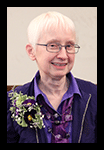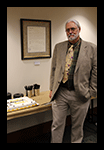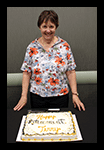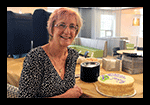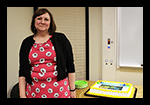"To build up the future, you have to know the past." — Otto Frank
Over the next few months as Purdue University Libraries relocates six libraries into the Wilmeth Active Learning Center (WALC), INSIDe will feature a brief history about each library.
A LOOK BACK AT LIFE SCIENCES LIBRARY
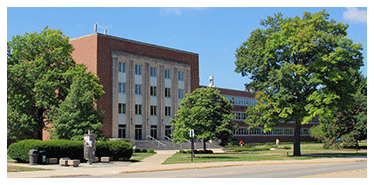 The first wing of the Lilly Hall of Life Sciences building was under construction beginning in 1951 and was first occupied in 1954 by the Agronomy Department. Other parts of the building were constructed as tax funds were made available. Walter Scholar, a local firm, was the architect for the building and Adolph Wolter, an Indianapolis sculptor, designed and made the aluminum mural hanging in the main foyer. The building was dedicated on September 18, 1959 with such dignitaries in attendance as Dean Earl Butz, Governor Harold Handley, and Purdue’s president, Dr. Frederick L. Hovde. The building’s basement, ground floor, and three floors above contain 499,877 square feet of floor space, or 11.5 acres, and 750 rooms. The first wing of the Lilly Hall of Life Sciences building was under construction beginning in 1951 and was first occupied in 1954 by the Agronomy Department. Other parts of the building were constructed as tax funds were made available. Walter Scholar, a local firm, was the architect for the building and Adolph Wolter, an Indianapolis sculptor, designed and made the aluminum mural hanging in the main foyer. The building was dedicated on September 18, 1959 with such dignitaries in attendance as Dean Earl Butz, Governor Harold Handley, and Purdue’s president, Dr. Frederick L. Hovde. The building’s basement, ground floor, and three floors above contain 499,877 square feet of floor space, or 11.5 acres, and 750 rooms.
Records indicate that the Life Sciences Library’s first beginnings were a collection of about 1200 volumes of Herd Records of all the principal American breeds of cattle, horses, sheep and swine and were housed in the Agricultural Building. In the 1904-1905 annual report of the library William M. Hepburn, librarian, reported that the agricultural and mathematical “collections” had just moved to the Main Library from the other campus locations. At the time, the expenditures for the books, periodicals and binding totaled $2,120. Of this, $1,061 was spent for books, the expenditures by department were $285 for engineering, $275 for sciences, $263 for humanities and social sciences, $35 for agriculture, $25 for pharmacy, and $285 for reference books. The average price paid per volume purchased was $1.57.
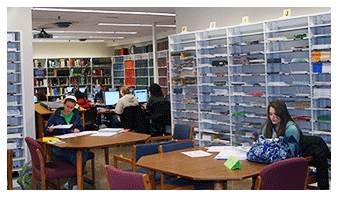 The 1908-1909 annual library report noted that a shelf-list of books on agricultural subjects was kept in the office of the Dean of the School of Agriculture and a catalog of biological literature was on file in the office of the Dean of the School of Science, in addition to the card catalog maintained in the Main Library. The 1908-1909 annual library report noted that a shelf-list of books on agricultural subjects was kept in the office of the Dean of the School of Agriculture and a catalog of biological literature was on file in the office of the Dean of the School of Science, in addition to the card catalog maintained in the Main Library.
In 1922, recognizing a growing need by students in the technical and professional fields for specialized reference assistance, Mr. Hepburn proposed to develop departmental libraries “under the main roof of the Main Library” by setting apart certain portions of the building for specific subjects. The first, (and possibly the only) subject area to be set apart was for agriculture. The old “study room” in the southwest corner of the building was converted to an “Agriculture Reading and Reference Room” with the agricultural collection located in the adjacent first “old” stack level.
In 1927, the establishment of the Biology Library was set in motion when Dr. Stanley Coulter donated
250 volumes to the Biology Department for use by students and staff in the various offices and laboratories in the Biology Department.
By 1942, several other departments had established their own collections within their offices and buildings in order to satisfy the growing needs of their students and staff as well as a means of meeting accreditation requirements.
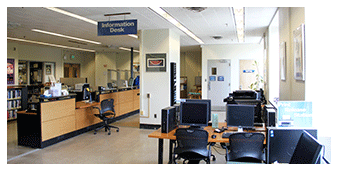 In 1944-1945, the holdings of the Agricultural Experiment Station Library were listed for inclusion in the General (Main) Library catalog. The Experiment Station Library remained completely independent of the campus library system until 1948-1949. In 1944-1945, the holdings of the Agricultural Experiment Station Library were listed for inclusion in the General (Main) Library catalog. The Experiment Station Library remained completely independent of the campus library system until 1948-1949.
Planning began in 1954 for the Life Sciences Library. The new library would be a combination of several department libraries and private collections that would fall under the supervision of the Director of Libraries, John Moriarty, and the Life Sciences Librarian. The library’s move from Stanley Coulter Hall was completed in time for the dedication ceremony of the Lilly Hall of Life Sciences in September 1959.
The Life Sciences Library, housed in Room 2-400, has not seen any major structural changes since its initial move. The library occupied three floors within Lilly Hall. Circulation, Reserves, current periodicals, reference materials and staff offices occupied the first floor. The second and third floors house study tables and carrels, the remaining collections and librarians’ offices.
By 1980, the Library included departmental collections from Agriculture and Biological Engineering, Agronomy, Animal Sciences, Biological Sciences, Botany and Plant Pathology, Entomology, Forestry and Natural Resources, and Horticulture. The Biochemistry Department continued to provide housing for its collection with daily operations and maintenance of the library falling under the supervision of the Life Sciences Librarian until 2004 when the space was vacated and the collections moved to the Life Sciences Library. When the Consumer and Family Sciences Library (CFS) closed in 2007, a portion of that collection (nutrition sciences) was added to Life Sciences.
In 2009, the 4th floor journal collection was shifted to create room and adequate growth space for the LC books.
Life Sciences Librarians since 1959, include James Martindale (Agricultural Experiment Station Library), Henry Murphy, Thomas Marshall, Henry Murphy, Chuck Schaeve, Ruth Ahl, Martha Bailey, and Sarah Kelly. In 2005, Vicki Killion became Head of the Health & Life Sciences Division which includes Life Sciences, Pharmacy, Nursing and Health Sciences, and Veterinary Medical Libraries. |

 David Hovde’s mention last month of the Libraries’ first CD-ROM product got me reminiscing about technology, and how far we’ve come. He noted that back in 1989 we got ERIC (Education Resources Information Center), which provides an index to education resources. CD-ROM was all the rage in the late 1980s, shortly after an influential book was published: CD ROM. The New Papyrus. The Libraries created a task force in 1987 to assess the impact of the technology on Libraries’ services. Then Director Joseph Dagnese, who was skeptical of the new technology, said the final report was “one of the most thorough reports I have ever received,” and it helped persuade him to approve the purchase of ERIC on CD-ROM. (I have a copy of the report if you want to see it.)
David Hovde’s mention last month of the Libraries’ first CD-ROM product got me reminiscing about technology, and how far we’ve come. He noted that back in 1989 we got ERIC (Education Resources Information Center), which provides an index to education resources. CD-ROM was all the rage in the late 1980s, shortly after an influential book was published: CD ROM. The New Papyrus. The Libraries created a task force in 1987 to assess the impact of the technology on Libraries’ services. Then Director Joseph Dagnese, who was skeptical of the new technology, said the final report was “one of the most thorough reports I have ever received,” and it helped persuade him to approve the purchase of ERIC on CD-ROM. (I have a copy of the report if you want to see it.) 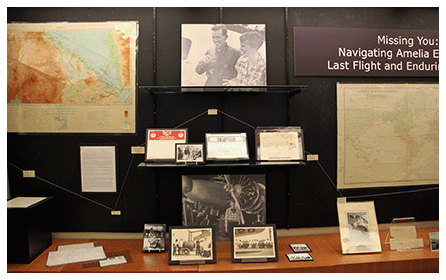 The mystery surrounding Amelia Earhart’s disappearance often overshadows her legacy as a pioneer aviator, vocal advocate for women’s opportunities in the workplace, in the university and at home — a legacy we do not want to miss. On this 80th anniversary of Earhart and Noonan’s disappearance, “Missing You” explores their last flight through their “eyes” via letters, telegrams, photographs and logs sent home. The exhibit also examines the unique role Earhart played to promote women’s rights during the 1920s and 1930s. Amelia Earhart was, and remains, a role model for young women and men.
The mystery surrounding Amelia Earhart’s disappearance often overshadows her legacy as a pioneer aviator, vocal advocate for women’s opportunities in the workplace, in the university and at home — a legacy we do not want to miss. On this 80th anniversary of Earhart and Noonan’s disappearance, “Missing You” explores their last flight through their “eyes” via letters, telegrams, photographs and logs sent home. The exhibit also examines the unique role Earhart played to promote women’s rights during the 1920s and 1930s. Amelia Earhart was, and remains, a role model for young women and men. 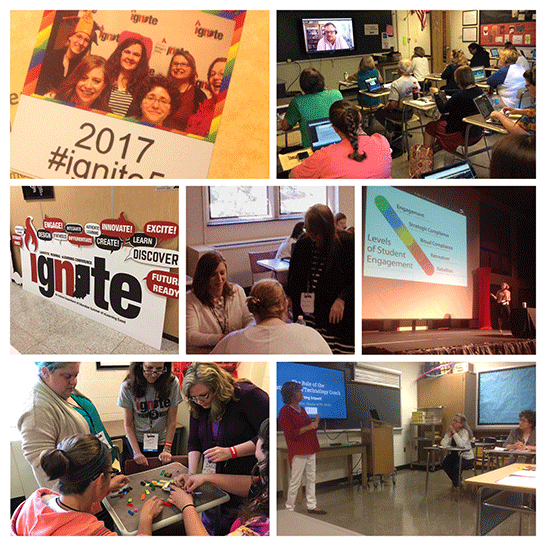 This year members of the Libraries Instructional Support Working Group, with staff representation from every Libraries division, returned to the 5th Annual Lafayette Regional E-Learning Conference at Jefferson High School June 7-8, making this the third consecutive year that Purdue Libraries Staff has attended this event.
This year members of the Libraries Instructional Support Working Group, with staff representation from every Libraries division, returned to the 5th Annual Lafayette Regional E-Learning Conference at Jefferson High School June 7-8, making this the third consecutive year that Purdue Libraries Staff has attended this event.  The first wing of the Lilly Hall of Life Sciences building was under construction beginning in 1951 and was first occupied in 1954 by the Agronomy Department. Other parts of the building were constructed as tax funds were made available. Walter Scholar, a local firm, was the architect for the building and Adolph Wolter, an Indianapolis sculptor, designed and made the aluminum mural hanging in the main foyer. The building was dedicated on September 18, 1959 with such dignitaries in attendance as Dean Earl Butz, Governor Harold Handley, and Purdue’s president, Dr. Frederick L. Hovde. The building’s basement, ground floor, and three floors above contain 499,877 square feet of floor space, or 11.5 acres, and 750 rooms.
The first wing of the Lilly Hall of Life Sciences building was under construction beginning in 1951 and was first occupied in 1954 by the Agronomy Department. Other parts of the building were constructed as tax funds were made available. Walter Scholar, a local firm, was the architect for the building and Adolph Wolter, an Indianapolis sculptor, designed and made the aluminum mural hanging in the main foyer. The building was dedicated on September 18, 1959 with such dignitaries in attendance as Dean Earl Butz, Governor Harold Handley, and Purdue’s president, Dr. Frederick L. Hovde. The building’s basement, ground floor, and three floors above contain 499,877 square feet of floor space, or 11.5 acres, and 750 rooms. The 1908-1909 annual library report noted that a shelf-list of books on agricultural subjects was kept in the office of the Dean of the School of Agriculture and a catalog of biological literature was on file in the office of the Dean of the School of Science, in addition to the card catalog maintained in the Main Library.
The 1908-1909 annual library report noted that a shelf-list of books on agricultural subjects was kept in the office of the Dean of the School of Agriculture and a catalog of biological literature was on file in the office of the Dean of the School of Science, in addition to the card catalog maintained in the Main Library. In 1944-1945, the holdings of the Agricultural Experiment Station Library were listed for inclusion in the General (Main) Library catalog. The Experiment Station Library remained completely independent of the campus library system until 1948-1949.
In 1944-1945, the holdings of the Agricultural Experiment Station Library were listed for inclusion in the General (Main) Library catalog. The Experiment Station Library remained completely independent of the campus library system until 1948-1949.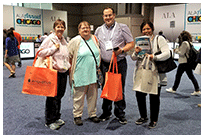
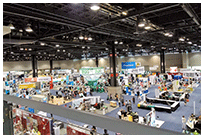
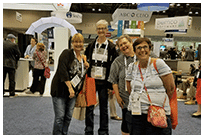
 Dean Lingley’s name was randomly drawn from all those who were SMILED upon in June. He received a $25 Von’s Book Shop gift certificate.
Dean Lingley’s name was randomly drawn from all those who were SMILED upon in June. He received a $25 Von’s Book Shop gift certificate.